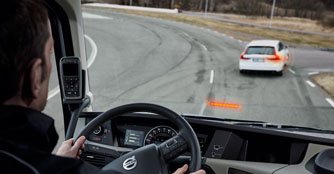Volvo Trucks' intelligent safety systems to minimise risk of traffic accidents
05 May 2017|4,003 views
More vehicles on the roads, a faster traffic flow and a distracting stream of information all impose considerable demands on both commercial vehicle drivers and car drivers. On the other hand, there has never been more opportunities for the person behind the wheel to drive more safely than there is today.
The active safety systems found in many modern cars and trucks make it far easier to avoid incidents and accidents. As of November 2015 there has been an EU-wide legal requirement for new two and three-axle heavy trucks to be equipped with an automatic emergency brake function.
The aim is to reduce accidents in which a truck drives into the rear of the vehicle in front, an accident scenario that accounts for about one-fifth of all road accidents involving trucks. At present, legislation requires that the emergency braking system must reduce the truck's speed by 10km/h. Next year, this will be tightened to 20km/h.
"It's great that the legislation is becoming stricter but I still feel the legal requirements are too low. If you are driving at 80km/h when the emergency braking system is deployed, you need to cut your speed by far more than just 20km/h to avoid a massive collision if the vehicle in front has come to a standstill," says Carl Johan Almqvist, Traffic & Product Safety Director at Volvo Trucks.
Volvo Trucks has developed a system that goes well beyond both current and future legal requirements. The system, which was introduced in 2012, focuses primarily on alerting the driver to the risk of a collision. The emergency brake is only used if it is absolutely necessary, and it is deployed extremely quickly.
The braking speed - or retardation to use the correct technical term - is about 7m/s2 , which is on par with what many passenger cars can manage. In practice this means that the truck's speed can be cut from 80-0km/h in about 40m.
Considering the short period that has passed since the introduction of emergency brake legislation, it will take some time before its positive effects are reflected in accident statistics. However, Volvo Trucks is convinced of the benefits of the emergency braking system and other active safety devices.
More vehicles on the roads, a faster traffic flow and a distracting stream of information all impose considerable demands on both commercial vehicle drivers and car drivers. On the other hand, there has never been more opportunities for the person behind the wheel to drive more safely than there is today.
The active safety systems found in many modern cars and trucks make it far easier to avoid incidents and accidents. As of November 2015 there has been an EU-wide legal requirement for new two and three-axle heavy trucks to be equipped with an automatic emergency brake function.
The aim is to reduce accidents in which a truck drives into the rear of the vehicle in front, an accident scenario that accounts for about one-fifth of all road accidents involving trucks. At present, legislation requires that the emergency braking system must reduce the truck's speed by 10km/h. Next year, this will be tightened to 20km/h.
"It's great that the legislation is becoming stricter but I still feel the legal requirements are too low. If you are driving at 80km/h when the emergency braking system is deployed, you need to cut your speed by far more than just 20km/h to avoid a massive collision if the vehicle in front has come to a standstill," says Carl Johan Almqvist, Traffic & Product Safety Director at Volvo Trucks.
Volvo Trucks has developed a system that goes well beyond both current and future legal requirements. The system, which was introduced in 2012, focuses primarily on alerting the driver to the risk of a collision. The emergency brake is only used if it is absolutely necessary, and it is deployed extremely quickly.
The braking speed - or retardation to use the correct technical term - is about 7m/s2 , which is on par with what many passenger cars can manage. In practice this means that the truck's speed can be cut from 80-0km/h in about 40m.
Considering the short period that has passed since the introduction of emergency brake legislation, it will take some time before its positive effects are reflected in accident statistics. However, Volvo Trucks is convinced of the benefits of the emergency braking system and other active safety devices.
Latest COE Prices
August 2025 | 2nd BIDDING
NEXT TENDER: 03 Sep 2025
CAT A$104,524
CAT B$124,400
CAT C$72,190
CAT E$125,001
View Full Results Thank You For Your Subscription.



















